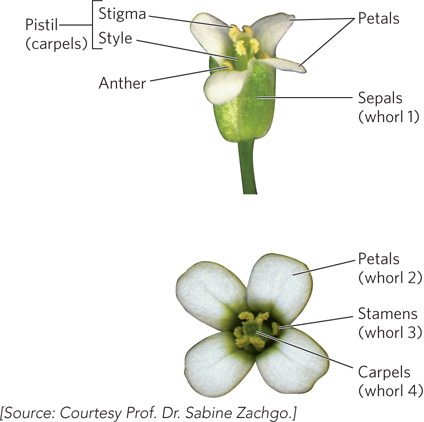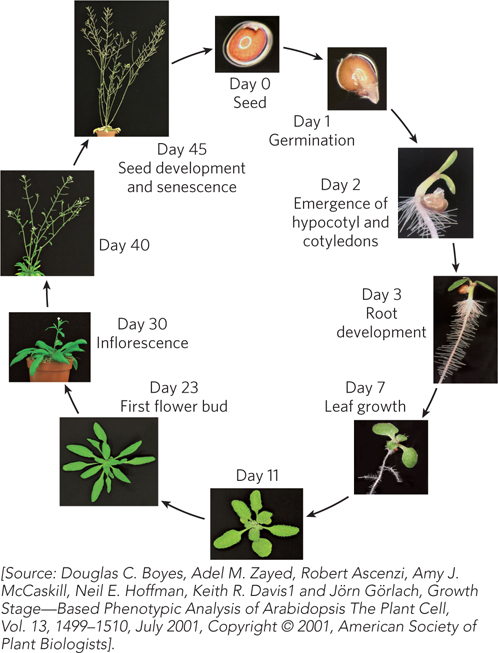Mustard Weed, Arabidopsis thaliana

Arabidopsis thaliana is an angiosperm, a dicot of the mustard family (Brassicaceae), which includes the more familiar broccoli, cabbage, and radish. Arabidopsis is generally regarded as a weed, but what it lacks in economic importance it makes up for in its special features as an experimental model. Arabidopsis is relatively small, allowing many plants to be grown in a confined space. It has a short life cycle, about 5 to 6 weeks from seed to flower, and each plant is capable of self-
Arabidopsis is a model for the physiology, development, genetics, and structure of all plants. It is also a model for how plants interact with the environment and sense day length, cold, drought, and salt, and how they respond to pathogens. We can expect many differences between plants and animals in the genetics of developmental programs. Nonetheless, studies on development of the flower whorl reveal a deep interconnection with animals. The flower whorl consists of four concentric rings (Figure A-

Early Studies of Arabidopsis as a Model Organism
Arabidopsis is a relatively recent addition to the select group of model organisms, developed into a robust model in the 1980s. In 1907, Friedrich Laibach identified the number of chromosomes in Arabidopsis, and in the 1940s he proposed the use of this plant as a model organism. With the help of Albert Kranz, Laibach collected and organized a large variety of ecotypes, which contributed to the current collection of 750 accessions of Arabidopsis. The beginnings of an Arabidopsis research community became evident with publication of a newsletter in the early 1960s, and the first International Arabidopsis Conference was held in 1965. By the 1980s, Arabidopsis was one of several plant models that also included the well-
Life Cycle
Arabidopsis has a common plant life cycle (Figure A-

A-
Genetic Techniques
Mutagenesis Plants can be mutagenized by treating the seeds with ionizing radiation or chemical mutagens. Plants that are homozygous for recessive mutant genes are easily obtained by self-
Complementation Arabidopsis in bloom is self-
Introduction of DNA Transformation with recombinant DNA is mediated by Agrobacterium tumefaciens T-
Gene Knockouts Homologous recombination of transgenic DNA, producing a gene knockout, occurs only rarely in plants and is not typically used in plant studies. However, large collections of sequenced Arabidopsis mutants are available, and specific insertions in individual genes can be ordered from stock centers.
Interference Gene function in Arabidopsis can be effectively knocked out using RNAi (see Chapter 22).
Arabidopsis as a Model Organism Today
Plant Evolution The 750 or so different natural accessions of Arabidopsis vary considerably in development and form (e.g., leaf shape, flowering time, hairiness, resistance to disease), and these are being studied to explain the evolution of traits and plant responses to the environment.
Light Sensing Plants have a variety of responses to light, and Arabidopsis is a genetic model for some of these. One such response is the switch from leaf to flower production. Arabidopsis flowers in response to an increase in day length and is a model for day-
Circadian Rhythms As we might expect for organisms with an immobile lifestyle and a dependence on light, plants display strong circadian rhythms. Arabidopsis provides an excellent model for exploring the genetic basis of circadian rhythms in plants and the nature of the mysterious “rhythmic oscillator.”
Plant Resistance to Pathogens Plants have a wide variety of strategies to survive stressful conditions, including invading pathogens, and Arabidopsis is a model for pathogen detection and defense. Among these defenses are antimicrobial molecules, development of physical barriers, and triggering of programmed cell death.
Genetics of Plant Development As a multicellular organism, Arabidopsis has a variety of organs and tissue types, each with its own genetics of development. Areas of developmental study include leaf growth, formation of flower whorls, seeds, and roots, development of vascular tissue, embryogenesis, and development of the flower body plan.
A-